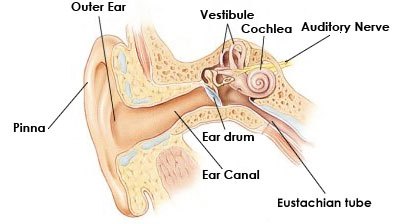
Image courtesy
Sound travels in
Let's take a look at an example. Imagine a church bell. When a bell rings, it vibrates, which means the bell itself flexes inward and outward very rapidly. As the bell moves outward, it pushes against particles of air. Those air particles then push against other adjacent air particles, and so on. As the bell flexes inward, it pulls against the adjacent air particles, and they, in turn, pull against other air particles. This push and pull pattern is a sound wave. The vibrating bell is the original disturbance, and the air particles are the medium.
molecules, creating a sound wave.
Sound isn't restricted to moving through the air. Press your ear against a solid surface like a table and close your eyes. Tell someone else to tap his or her finger on the other end of the table. The tapping becomes the initial disturbance. Each tap sends vibrations through the table. The particles in the table collide with each other and become the medium for the sound. The particles in the table collide with air particles between the table and your
The air particles collide with your ear's
So, sound needs a physical medium in order to travel anywhere. Is there enough physical material in
THE SPEED OF SOUND
The speed of a sound wave depends upon the medium through which it travels. In general, sound travels faster through solids than through liquids or gases. Also, the denser the medium, the slower sound will travel through it. The same sound will travel at a different speed on a cold day than it would on a warm day.
(Source: How stuff works?)


